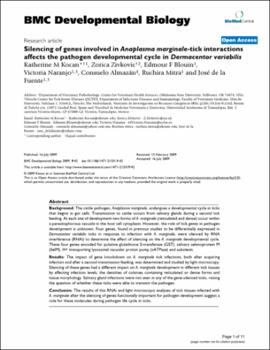| dc.contributor.author | Kocan, Katherine M. | |
| dc.contributor.author | Zivkovic, Zorica | |
| dc.contributor.author | Blouin, Edmour F. | |
| dc.contributor.author | Naranjo, Victoria | |
| dc.contributor.author | Almazan, Consuelo | |
| dc.contributor.author | Mitra, Ruchira | |
| dc.contributor.author | de la Fuente, Jose | |
| dc.date.accessioned | 2018-11-09T21:10:47Z | |
| dc.date.available | 2018-11-09T21:10:47Z | |
| dc.date.issued | 2009-07-16 | |
| dc.identifier | oksd_kocan_silencingofgene_2009 | |
| dc.identifier.citation | Kocan, K. M., Zivkovic, Z., Blouin, E. F., Naranjo, V., Almazan, C., Mitra, R., & de la Fuente, J. (2009). Silencing of genes involved in Anaplasma marginale-tick interactions affects the pathogen developmental cycle in Dermacentor variabilis. BMC Developmental Biology, 9, Article 42. https://doi.org/10.1186/1471-213X-9-42 | |
| dc.identifier.uri | https://hdl.handle.net/11244/302055 | |
| dc.description.abstract | Background: The cattle pathogen, Anaplasma marginale, undergoes a developmental cycle in ticks that begins in gut cells. Transmission to cattle occurs from salivary glands during a second tick feeding. At each site of development two forms of A. marginale (reticulated and dense) occur within a parasitophorous vacuole in the host cell cytoplasm. However, the role of tick genes in pathogen development is unknown. Four genes, found in previous studies to be differentially expressed in Dermacentor variabilis ticks in response to infection with A. marginale, were silenced by RNA interference (RNAi) to determine the effect of silencing on the A. marginale developmental cycle. These four genes encoded for putative glutathione S-transferase (GST), salivary selenoprotein M (SelM), H+ transporting lysosomal vacuolar proton pump (vATPase) and subolesin. | |
| dc.description.abstract | Results: The impact of gene knockdown on A. marginale tick infections, both after acquiring infection and after a second transmission feeding, was determined and studied by light microscopy. Silencing of these genes had a different impact on A. marginale development in different tick tissues by affecting infection levels, the densities of colonies containing reticulated or dense forms and tissue morphology. Salivary gland infections were not seen in any of the gene-silenced ticks, raising the question of whether these ticks were able to transmit the pathogen. | |
| dc.description.abstract | Conclusion: The results of this RNAi and light microscopic analyses of tick tissues infected with A. marginale after the silencing of genes functionally important for pathogen development suggest a role for these molecules during pathogen life cycle in ticks. | |
| dc.format | application/pdf | |
| dc.language | en_US | |
| dc.publisher | BioMed Central | |
| dc.rights | This material has been previously published. In the Oklahoma State University Library's institutional repository this version is made available through the open access principles and the terms of agreement/consent between the author(s) and the publisher. The permission policy on the use, reproduction or distribution of the material falls under fair use for educational, scholarship, and research purposes. Contact Digital Resources and Discovery Services at lib-dls@okstate.edu or 405-744-9161 for further information. | |
| dc.title | Silencing of genes involved in Anaplasma marginale-tick interactions affects the pathogen developmental cycle in Dermacentor variabilis | |
| osu.filename | oksd_kocan_silencingofgene_2009.pdf | |
| dc.description.peerreview | Peer reviewed | |
| dc.identifier.doi | 10.1186/1471-213X-9-42 | |
| dc.description.department | Veterinary Pathobiology | |
| dc.type.genre | Article | |
| dc.type.material | Text | |
| dc.subject.keywords | salivary gland | |
| dc.subject.keywords | white spot syndrome virus | |
| dc.subject.keywords | developmental cycle | |
| dc.subject.keywords | light microscopy analysis | |
| dc.subject.keywords | tick cell | |
